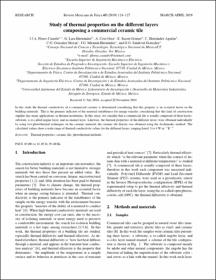| dc.contributor.author | Flores Cuautle, Jose de Jesus Agustin | |
| dc.contributor.author | Lara Hernandez, Gemima | |
| dc.contributor.author | Cruz Orea, Alfredo | |
| dc.contributor.author | Suaste Gomez, Ernesto | |
| dc.contributor.author | Hernandez Aguilar, Claudia | |
| dc.contributor.author | Gonzalez Moran, Carlos Omar | |
| dc.contributor.author | Miranda Hernandez, Jose Guadalupe | |
| dc.contributor.author | Sandoval Gonzalez, Oscar Osvaldo | |
| dc.date.accessioned | 2022-06-28T16:35:40Z | |
| dc.date.available | 2022-06-28T16:35:40Z | |
| dc.date.issued | 2019-03 | |
| dc.identifier.citation | Articulo JCR | es |
| dc.identifier.issn | 0035-001X | |
| dc.identifier.uri | http://repositorios.orizaba.tecnm.mx:8080/xmlui/handle/123456789/565 | |
| dc.description | In this study the thermal conductivity of a commercial ceramic is determined considering that this property is an essential factor on the building materials. This is the primary indicator of the material suitableness for energy transfer, considering that this kind of construction supplies has many applications as thermal insulations. In this sense, we consider that a commercial tile is usually composed of three layers: substrate, a so-called engine layer, and an enamel layer. Likewise, the thermal properties of the different layers were obtained individually by using two photothermal techniques on the ceramic material; the ceramic tile density was obtained using the Archimedes method. The calculated values show a wide range of thermal conductivity values for the different layers, ranging from1.3 to 4 W m-1K-1. | es |
| dc.description.abstract | In this study the thermal conductivity of a commercial ceramic is determined considering that this property is an essential factor on the building materials. This is the primary indicator of the material suitableness for energy transfer, considering that this kind of construction supplies has many applications as thermal insulations. In this sense, we consider that a commercial tile is usually composed of three layers: substrate, a so-called engine layer, and an enamel layer. Likewise, the thermal properties of the different layers were obtained individually by using two photothermal techniques on the ceramic material; the ceramic tile density was obtained using the Archimedes method. The calculated values show a wide range of thermal conductivity values for the different layers, ranging from1.3 to 4 W m-1K-1. | es |
| dc.language.iso | en_US | es |
| dc.publisher | Revista Mexicana de Física | es |
| dc.relation.ispartofseries | Revista Mexicana de Fisica; | |
| dc.subject | Thermal properties | es |
| dc.subject | ceramic tile | es |
| dc.subject | photothermal methods | es |
| dc.title | Study of thermal properties on the different layers composing a commercial ceramic tile | es |
| dc.type | Article | es |



